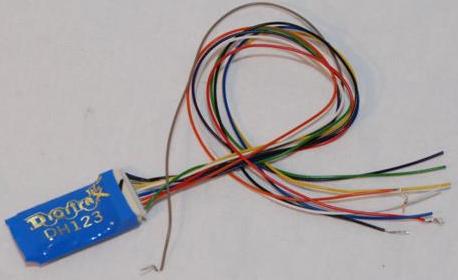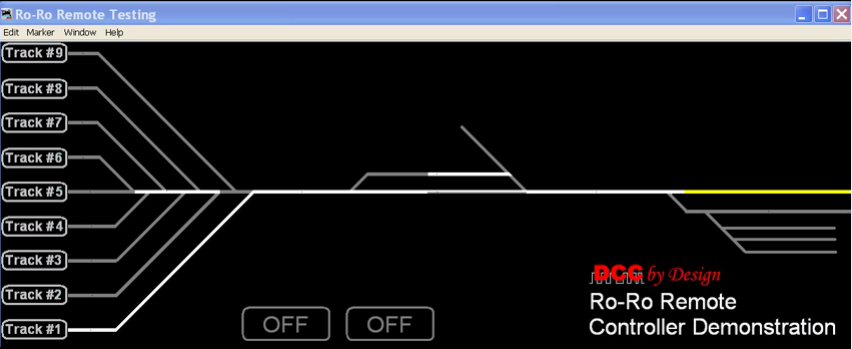When considering what type of mobile decoder to buy there are several aspects worth considering to select the unit to buy. Primary considerations include plug and play capability, sound, number of Functions (lights), price, and special features. Secondary considerations are vendor specific functions, vendor preference, and DCC set used.
This article and the others on this site provide basic information to educate DCC consumers. DCC by Design offers the service of designing a DCC system for you. As part of our Design Services we will work with you to examine your existing fleet of locomotives to determine how best to convert them to DCC. In the process we address the issues below and many, many more. Then we convert your preferences, layout design, and budget into a complete DCC system.
We offer this free information as a small sample of how we can help you with our Design Services. Drop us note so we can discuss with you improvements for your current or design for your next layout.
Plug-n-Play
With the advent of DCC, locomotive manufacturers soon developed “DCC ready” locomotives. These locomotives are built with DCC in mind and are provided with a specific electrical plug or other feature that allows for simple installation of mobile decoder. Frequently, these locomotives are also available “DCC equipped” with a mobile decoder from the locomotive manufacturer. The range of solutions for “DCC ready” are generally scale specific. For example HO locomotives are generally equipped with an NMRA standard plug. However, due to size constraints, N scale locomotive generally require boards sized for a specific model and manufacturer of a locomotive. Thus, for N scale, a board designed for an Athearn SD70 will not fit in an Kato SD70. Likewise, a board for an Atlas SD60 won’t fit in an Atlas GP38. If the locomotive is widely available, then there will likely be more than one DCC mobile decoder available for that locomotive.
While this may seem confusing, most DCC manufacturers provide a page on their web site where you can look up a specific locomotive and see what decoder fits.
 |
 |
|
| N scale - SD80Mac with Plug-n-Play decoder |
HO Scale Sound Decoder - Plug & Play. - Note the 8 pins sticking up in the middle of the board. | Example decoder |
Sound
Many modelers now consider locomotives incomplete without sound. In fact, there are several manufacturers, such as Broadway Limited and Atlas that build sound equipped locomotive straight from the factory. Basically, sound equipped locomotives are DCC equipped. But what to do about those locomotives in one’s roster which are not sound equipped. If sound is desired, then buy a sound decoder that is also a motor (mobile) decoder. While it is possible to mount separate sound and motor decoders, it is more difficult. Keeping mobile decoder installations simple is usually the best course. If you want sound, we recommended using sound decoders that are Plug-n-Play for your locomotive.
Functions (Lights)
Another key feature to consider when selecting a mobile decoder is the number of available functions. Generally these functions are specific to reproducing different types of locomotive lights, such as ditch lights, MARS lights, head lights, strobes, and fire boxes. Basic decoders typically have 2 functions, which are intended for the front and rear headlights. More sophisticated mobile decoders may have between six and eight functions, each of which is custom configurable for different types of lights. Each modeler must decide for themselves how important the correct light effects are to them. That said, additions functions is one of the least expensive features of a decoder.
PriceAs we all know, price tends to be the overwhelming deciding factor. In deciding how much to spend on a decoder, I would suggest that one plan to spend about 30 to 40% of the cost of the locomotive. For example, if one spent $75 dollars on an N scale diesel locomotive, then one could expect to spend between $22 and $30 on a decoder. Indeed, the prices I’ve seen for basic and advance light only decoders is in this range. If one spent $150 on an HO steam, then the decoder cost would be about $45 to $60, which equates to street prices for premium light or cheap sound decoders. Clearly one may spend more that my recommendation for a decoder, if one of the other features, most likely sound, is too important to live without. |
Mobile Decoder Price GuidelineTypically the price of a mobile decoder should be 30% to 40% of the cost of the locomotive. Exception - Premium Sound: |
Secondary Considerations
Secondary considerations are generally those that indicate a preference in vendor for mobile decoders. Thanks to the NMRA standards, any mobile decoder will work with any other DCC system. Therefore, a modeler does not limit their choices in mobile decoders based on their starter system. However, some vendors have proprietary features that may require you buy their decoders. One example is Digitrax’s Transponding; this system allows a modeler to determine and track the location of a specific locomotive, or transponder equipped car, on the layout. In order for Transponding to work, all mobile decoders must have a transponder chip. Since this technology is unique to Digitrax, implementing Transponding requires use of only Digitrax mobile decoders. Personally I find this technology sufficient worthwhile to implement on my home N scale layout. Another example is Lenz Gold Series Decoders, when equipped with a storage module, the locomotive can operate, and receive signal on very dirty track. For some people, this technology may be sufficient to desire only Lenz decoders.
Factory Decoders
As noted above many “DCC ready” locomotives are also offered with factory installed mobile decoders. Sound equipped locomotives almost always have factory installed decoders. My recommendation is to buy locomotives with factory installed decoders, unless one has a compelling reason not to. These are the only compelling reasons not to buy factory installed decoders that I can think of:
- Factory Installed decoder is not available – Believe it or not, there are still many locomotives on the market which are not available with factory decoders. The larger the scale, the more likely it does not have factory installed decoder option.
- Factory Installed decoder does not include sound – Many modelers today won’t buy a locomotive without a sound option. Frequently, however, that option involves an aftermarket kit.
- Factory Installed decoder does not include key option – Options such as Transponding or dirty track capability are propriety and only available on after market decoders.
Role of Scale in Selection
The scale of one’s models has an impact on the available and choices in mobile decoders. Here is a quick guide to the role of scale in choosing a decoder:
Z Scale - Size is extremely challenging.
N Scale
- Size is a challenge, but generally there are Plug-n-play decoders available, usually from more than one manufacturer.
- Plugs and Harnesses are rarely used. More typical is custom designed Plug-n-play decoders. This results in fewer, more expensive choices than HO.
- Installing in older locomotive requires milling frame which some say is detrimental to performance. For me it was a good excuse to sell entire roster and start anew with better models.
- Sound is very difficult. Precision Craft Models (and LokSound) offer sound equipped locomotives, but only for F7s and other wide locomotives. I suggest skip sound at this scale and keep your figures crossed for SurroundTraxx.
HO Scale
- Size is a not particularly challenging, except for small switchers,
- Plugs and Harnesses are typically used, which means a wide variety and price of mobile decoders.
- Sound unit are readily available for most locomotives and fairly easy to install, if not shipped from factory with sound
O Scale
- Size gives plenty of room…and weight
- Sound is excellent, especially in factory equipped locomotives
- Plenty of room of other features such as remote couplers, automatic pantographs, etc.
- Generally higher amp motors which limits after market mobile decoder selections.
Older Locomotives
One of the most frequent questions modelers ask when moving to DCC is whether or not to upgrade older locomotives. This is a difficult question and it encompasses many facets; technical reasons, sentimental value, size of roster, etc. I will try to focus on technical questions.
One of the first considerations is that DCC will not improve a poorly running locomotive. If it runs poorly on DC, then it is not worth the cost and work to upgrade.
The next consideration is that older locomotives must have their stall current measured. Newer locomotives have much more efficient motors than the older locomotives. Consequently, the mobile decoders are typically designed for less than 1 amp max current. If the older locomotive draws more than one amp at stall, it will require a bigger, more expense decoder. While much has been written on this issue, based on the club members conversion that I know about, I do not think it is as big a challenge as other sites claim.
Smaller scale locomotives, especially N scale that do not have plug and play decoders available, will need to have the frame milled. This is challenging work and may be too great a hurdle. Personally, it was for me.
The best advise is to take each locomotive on a case-by-case basis. This email address is being protected from spambots. You need JavaScript enabled to view it. so we can discuss your locomotive fleet's needs.


 Today we posted information about our
Today we posted information about our 

